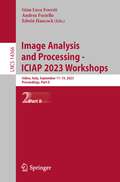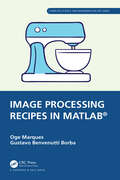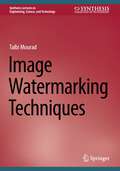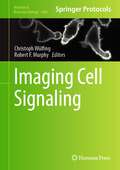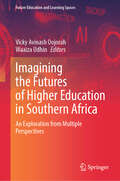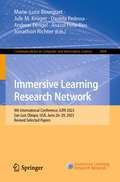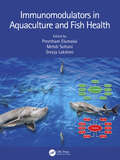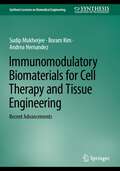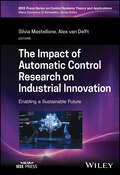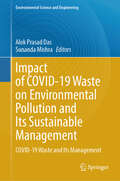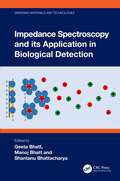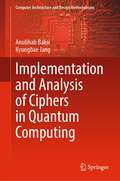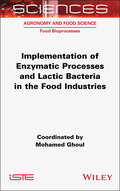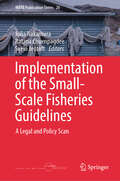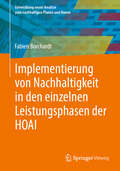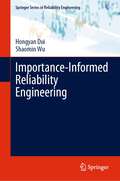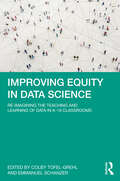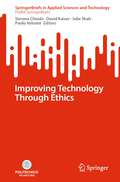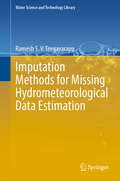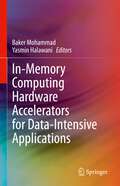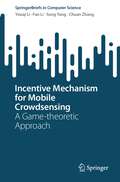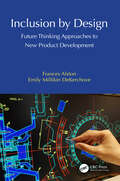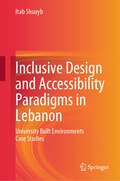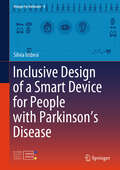- Table View
- List View
Image Analysis and Processing - ICIAP 2023 Workshops: Udine, Italy, September 11–15, 2023, Proceedings, Part II (Lecture Notes in Computer Science #14366)
by Gian Luca Foresti Andrea Fusiello Edwin HancockThe two-volume set LNCS 14365 and 14366 constitutes the papers of workshops hosted by the 22nd International Conference on Image Analysis and Processing, ICIAP 2023, held in Udine, Italy, in September 2023.In total, 72 workshop papers and 10 industrial poster session papers have been accepted for publication. Part II of the set, volume 14366, contains 41 papers from the following workshops:– Medical Imaging Hub:• Artificial Intelligence and Radiomics in Computer-Aided Diagnosis (AIR-CAD)• Multi-Modal Medical Imaging Processing (M3IP)• Federated Learning in Medical Imaging and Vision (FedMed)– Digital Humanities Hub:• Artificial Intelligence for Digital Humanities (AI4DH)• Fine Art Pattern Extraction and Recognition (FAPER)• Pattern Recognition for Cultural Heritage (PatReCH)• Visual Processing of Digital Manuscripts: Workflows, Pipelines, BestPractices (ViDiScript)
Image Processing Recipes in MATLAB® (Chapman & Hall/CRC Computer Science and Engineering Recipes Series)
by Oge Marques Gustavo Benvenutti BorbaLeveraging the latest developments in MATLAB and its image processing toolbox, this 'cookbook' is a collection of 30 practical recipes for image processing, ranging from foundational techniques to recently published algorithms. Presented in a clear and meaningful sequence, these recipes are prepared with the reader in mind, allowing one to focus on particular topics or read as a whole from cover to cover.Key Features: A practical, user-friendly guide that equips researchers and practitioners with the tools to implement efficient image processing workflows in MATLAB. Each recipe is presented through clear, step-by-step instructions and rich visual examples. Each recipe contains its own source code, explanations, and figures, making the book an excellent standalone resource for quick reference. Strategically structured to aid sequential learning, yet with self-contained chapters for those seeking solutions to specific image processing challenges. The book serves as a concise and readable practical reference to deploy image processing pipelines in MATLAB quickly and efficiently. With its accessible and practical approach, the book is a valuable guide for those who navigate this evolving area, including researchers, students, developers, and practitioners in the fields of image processing, computer vision, and image analysis.
Image Watermarking Techniques (Synthesis Lectures on Engineering, Science, and Technology)
by Talbi MouradThis book investigates the image watermarking domain, analyzing and comparing image watermarking techniques that exist in current literature. The author’s goal is to aid researchers and students in their studies in the vast and important domain of image watermarking, including its advantages and risks. The book has three chapters: image watermarking using data compression; speech modulation for image watermarking; and secure image watermarking based on LWT and SVD.In addition, this book: Investigates the image watermarking domain, analyzing and comparing current image watermarking techniquesIncludes detail on image encryption and mathematical tools used for image watermarkingCovers image watermarking using data compression, speech modulation for image watermarking, and more
Imaging Cell Signaling (Methods in Molecular Biology #2800)
by Robert F. Murphy Christoph WülfingThis volume explores recent innovations across the entire pipeline of imaging signal transduction, cell preparation, cellular manipulation, image acquisition, and computational analysis. The chapters in this book cover topics such as rapid preparation of living Drosophila pupal macrophages for ex vivo imaging; controlling the potency of T cell activation using an optically tuneable chimeric antigen receptor; in situ imaging of proteins using DNA-PAINT super-resolution microscopy; reconstructing signaling networks using biosensor barcoding; and morphological, spatial, and dynamic models for cellular components. Written in the highly successful Methods in Molecular Biology series format, chapters include introductions to their respective topics, lists of the necessary materials and reagents, step-by-step, readily reproducible laboratory protocols, and tips on troubleshooting and avoiding known pitfalls.Cutting-edge and authoritative, Imaging Cell Signaling is a valuable resource that provides guidance to researchers looking to learn how to effectively tailor design projects to image, manipulate, and model signal transduction.
Imagining the Futures of Higher Education in Southern Africa: An Exploration from Multiple Perspectives (Future Education and Learning Spaces)
by Waaiza Udhin Vicky Avinash OojorahThis book showcases multiple perspectives about the futures of Higher Education from experts and other stakeholders in academia in the Southern African region, with each chapter presenting a different scenario of a possible future for Higher Education. It situates itself at the confluence of various fields of study such as Educational Technologies, Artificial Intelligence (AI), Sociology of Education, Sociology of the Future, Sustainable Development and Climate Change. It also includes various topics, such as digital development in terms of AI and emerging technologies, Higher Educational strategising and planning, the philosophical underpinnings of Higher Education and the present-day need for Sustainable Development models. Through the various chapters discussing the above-mentioned themes in the varied contexts of the Southern African region, this book helps readers engage in imaginative thinking regarding the future world and thus be prepared to embrace the challenges ahead. This book also underpins curriculum development for the new era firstly through new philosophical outlooks and secondly through ideas for novel learning areas in Higher Education and content to help shape minds for the twenty-first century. This book paves the way for innovation, progress and adaptation to the changing needs of the Higher Education clientele. It also attempts to influence policymaking, support advocates for sustainability and environmental education, prepare for technological advancements and improve the resilience and wellbeing of people in the region.
Immersive Learning Research Network: 9th International Conference, iLRN 2023, San Luis Obispo, USA, June 26–29, 2023, Revised Selected Papers (Communications in Computer and Information Science #1904)
by Marie-Luce Bourguet Jule M. Krüger Daniela Pedrosa Andreas Dengel Anasol Peña-Rios Jonathon RichterThis volume constitutes the refereed proceedings of the 9th International Conference of the Immersive Learning Network, iLRN 2023, held in San Luis Obispo, USA, in June 2023 as a hybrid event.The 26 revised full papers and 13 shprt papers presented in this volume were carefully reviewed and selected from 110 submissions. The papers are organized in topical sections on foundations in immersive learning research and theory; assessment and evaluation; galleries, libraries, archives and museums; inclusion, diversity, equity, access, and social justice; STEM education; language, culture and heritage; nature & environmental sciences; workforce development & industry training; self and co-regulated learning with immersive learning environments; special track: immersive learning across Latin America: state of research, use cases and projects.
Immunomodulators in Aquaculture and Fish Health
by Preetham Elumalai Mehdi Soltani Sreeja LakshmiThis reference book provides updated information about different immunomodulators for managing fish health and sustainable aquaculture. Immunomodulators are dietary additives that enhance innate defense mechanisms and increase resistance against specific pathogens and diseases. The book covers the different types of immunostimulants, their modes of action, and their efficacies. It also reviews safety concerns, ethical regulations, limitations, and outreach to farmers. It discusses the application of herbal immunomodulators, antioxidants, pre- and pro-biotics, in disease management. Features:• Reviews the pressing topic of reduction of antibiotic use in aquaculture • Discusses herbal immunomodulators, nutrients, antioxidants and pre- and pro-biotics • Covers the topic of progressive immunomodulation using nanotechnology • Discusses fish health management in the ever-growing aquaculture industry • Includes natural and synthetic immunomodulators The book is meant for researchers and industry experts in aquaculture, fisheries science, and veterinary medicine.
Immunomodulatory Biomaterials for Cell Therapy and Tissue Engineering: Recent Advancements (Synthesis Lectures on Biomedical Engineering)
by Sudip Mukherjee Boram Kim Andrea HernandezThis book presents the recent developments in immunomodulatory biomaterials for cell-based therapies in various diseases, including diabetes, cancer, cardiovascular disease, and bone regeneration. The authors first cover the fundamentals of conventional immunology and immunomodulation, before focusing on the history, advantages, and challenges of cell therapies. Biological cell therapy has gained immense attention for various diseases due to unique advantages it has over chemical drugs regarding cost, ease of production, toxicity, and therapeutic efficacy. However, these cell-based therapies need an inert delivery system that can locally deliver cells and minimally elicit foreign body response. The book discusses the foreign body response to the immunomodulatory biomaterials as well as the current and future strategies for potential mitigation of considerable immune responses toward immunomodulatory biomaterials and devices.
The Impact of Automatic Control Research on Industrial Innovation: Enabling a Sustainable Future (IEEE Press Series on Control Systems Theory and Applications)
by Silvia Mastellone Alex Van DelftThe Impact of Automatic Control Research on Industrial Innovation Bring together the theory and practice of control research with this innovative overview Automatic control research focuses on subjects pertaining to the theory and practice of automation science and technology subjects such as industrial automation, robotics, and human???machine interaction. With each passing year, these subjects become more relevant to researchers, policymakers, industrialists, and workers alike. The work of academic control researchers, however, is often distant from the perspectives of industry practitioners, creating the potential for insights to be lost on both sides. The Impact of Automatic Control Research on Industrial Innovation seeks to close this distance, providing an industrial perspective on the future of control research. It seeks to outline the possible and ongoing impacts of automatic control technologies across a range of industries, enabling readers to understand the connection between theory and practice. The result is a book that combines scholarly and practical understandings of industrial innovations and their possible role in building a sustainable world. The Impact of Automatic Control Research on Industrial Innovation readers will also find: Insights on industrial and commercial applications of automatic control theory. Detailed discussion of industrial sectors including power, automotive, production processes, and more. An applied research roadmap for each sector. This book is a must-own for both control researchers and control engineers, in both theoretical and applied contexts, as well as for graduate or continuing education courses on control theory and practice.
Impact of COVID-19 Waste on Environmental Pollution and Its Sustainable Management: COVID-19 Waste and Its Management (Environmental Science and Engineering)
by Alok Prasad Das Sunanda MishraThis book focuses on challenges that have arisen because of trash discharges and their potential causes and provides long-term sustainable solutions. Globally, the COVID-19 pandemic has caused immense devastation, leading to numerous fatalities as well as substantial economic losses and health issues. With the rise in COVID-19 cases, the amount of biomedical waste has multiplied, exposing more people to the epidemic. For developing countries, waste management is already a problem, and the waste generated during this pandemic situation has made things worse. If improper waste management techniques are not changed, the world will face a new crisis that could be referred to as a "garbage crisis." The increased quantity of COVID-19-associated waste (CAW) and their presence in the environment make them more vulnerable, potentially increasing the danger of food chain contamination. A few countries have already started putting emergency plans in place to address the “waste crisis.” Given the paucity of information on the mutational features and potential hosts of this newly discovered COVID-19, there is a pressing need for an effective plan to protect India's ecosystem against further contamination. To handle the current crisis and prevent the anticipated waste disaster, it is imperative to construct a more effective, automated, computerized, and well-modified waste management system during the COVID-19 period.
Impedance Spectroscopy and its Application in Biological Detection (Emerging Materials and Technologies)
by Geeta Bhatt Manoj Bhatt Shantanu BhattacharyaThis book includes basics of impedance spectroscopy technology, substrate compatibility issues, integration capabilities, and several applications in the detection of different analytes. It helps explore the importance of this technique in biological detection, related micro/nanofabricated platforms and respective integration, biological synthesis schemes to carry out the detection, associated challenges, and related future directions. The various qualitative/quantitative findings of several modules are summarized in the form of the detailed descriptions, schematics, and tables. Features: Serves as a single source for exploring underlying fundamental principles and the various biological applications through impedance spectroscopy Includes chapters based on nonbiological applications of impedance spectroscopy and IoT-enabled impedance spectroscopy-based methods for detection Discusses derivations, substrates, applications, and several integrations Describes micro/nanofabrication of impedance-based biological sensors Reviews updated integrations like digital manufacturing and IoT This book is aimed at researchers and graduate students in material science, impedance spectroscopy, and biosensing.
Implementation and Analysis of Ciphers in Quantum Computing (Computer Architecture and Design Methodologies)
by Anubhab Baksi Kyungbae JangThis book deals with the upcoming threat that may be posed by quantum computers on modern-day security standards, particularly those involving symmetric key ciphers. Considering the progress in the field of quantum computing over the past few years, there is an ever-growing need to analyze the ciphers that are being employed in ensuring security. The symmetric key ciphers are generally considered safe against quantum computers, though one must consider the possible impact due to Grover's search algorithm (that reduces the security claim to the square root bound of what is expected against a classical computer). This book consolidates all the major research works in one place and presents it with adequate clarity, making the subject matter easy to understand for seasoned researchers and students alike. It covers the prerequisite information, new research works (including some of the state of the art), thought-provoking problems for further research, and all the relevant source codes. This book is interesting to engineers, researchers, and students who work/study in the field of cryptography.
Implementation of Enzymatic Processes and Lactic Bacteria in the Food Industries (ISTE Consignment)
by Mohamed GhoulConsumers are demanding healthy, natural food products with no environmental impacts. The use of ingredients of plant origin and the implementation of bioprocesses using enzymes and micro-organisms as biocatalysts represent a promising alternative to satisfy this demand. Implementation of Enzymatic Processes and Lactic Bacteria in the Food Industries focuses on describing the latest developments in the use of enzymatic biocatalysts and lactic acid bacteria in the food industry. The first part of the book is devoted to the presentation of different classes of enzymes, production and application processes, ways of improving enzymes and the main industrial applications using biocatalysts. The second part of the book describes a family of micro-organisms widely used in health food processing and formulation: lactic acid bacteria and bifidobacteria. Then, the most commonly used encapsulation matrices, encapsulation processes and the process of bacterial adhesion to these matrices are discussed. Finally, the best-known fermented foods and new approaches developed in this field are presented.
Implementation of the Small-Scale Fisheries Guidelines: A Legal and Policy Scan (MARE Publication Series #28)
by Julia Nakamura Ratana Chuenpagdee Svein JentoftThis book provides a transdisciplinary assessment of multiple countries’ legal and policy frameworks vis-à-vis the Voluntary Guidelines for Securing Sustainable Small-Scale Fisheries in the Context of Food Security and Poverty Eradication, adopted in 2014 by the Committee on Fisheries of the Food and Agriculture Organization of the United Nations. Based on an appraisal framework used to facilitate the unpacking of those frameworks, this book collects country experiences and regional perspectives on a range of cross-cutting issues underpinning the protection of the rights and the promotion of justice for small-scale fishers and their communities.This book aims to be the first collection to present a systematic and in-depth assessment of existing national legal and policy frameworks vis-à-vis the SSF Guidelines. This assessment is done through the transdisciplinary and collaborative work of researchers, governments, and civil society organizations for the analysis of the cross-thematic questions, which the contributors of this book aim to address. Firstly, what are the relevant laws and policies that matter for securing rights of small-scale fishers and their communities? How are small-scale fisheries defined by national laws and policies? How are small-scale fisheries treated (i.e., specifically or generally) in these instruments? Are there specific provisions and references to small-scale fisheries or any of its associated terminologies (e.g., artisanal, subsistence, traditional, indigenous)? Secondly, how the relevant instruments address the 8 small-scale fisheries key issues outlined in that rapid appraisal study? What are the strengths and gaps in these instruments? Do they address issues that are not covered by the SSF Guidelines? Do they contribute to clarifying other legal issues that are relevant for sustainable small-scale fisheries? Finally, since the book also aims to explore the accessibility of these legal and policy instruments for those to which they matter the most (the small-scale fishers), the following questions were also considered: What challenges do they face in knowing and understanding the relevant laws and policies in place? Which tools, measures and processes are available in the countries to ensure small-scale fishers can claim for their rights? To what extent judicial courts have recognized and/or granted rights to small-scale fishers?Chapters 11 and 20 are available open access under a Creative Commons Attribution 4.0 International License via link.springer.com.
Implementierung von Nachhaltigkeit in den einzelnen Leistungsphasen der HOAI (Entwicklung neuer Ansätze zum nachhaltigen Planen und Bauen)
by Fabien BorchardtDas Buch bietet einen allgemeingültigen Leitfaden zur Implementierung von Nachhaltigkeitsaspekten in den einzelnen Leistungsphasen der HOAI. Dieser Leitfaden bezieht sich auf die Planung, Ausführung, Bewirtschaftung und Verwertung eines Neubaus hinsichtlich öffentlicher Gebäude. Die Inhalte und Beiträge des Leitfadens werden durch eine ausführliche Untersuchung des derzeitigen Standes der Technik und der Forschung angefertigt. Dabei werden die derzeitigen Regelwerke bzw. gültigen Standards, Bewertungs- und Zertifizierungssysteme, aktuelle Forschungsarbeiten sowie existierende Leitfäden begutachtet und für die eigene Arbeit bewertet. Der thematische Schwerpunkt dieser Arbeit liegt auf der anschließenden Entwicklung eines Leitfadens, welcher Nachhaltigkeitskriterien für die unterschiedlichen Stakeholder eines öffentlichen Bauvorhabens sowie deren Leistungsphasen gemäß HOAI festlegt. Die Nachhaltigkeitskriterien orientieren sich an der Optimierung der ökologischen, ökonomischen, soziokulturellen und technischen Qualität sowie an der Prozess- und Standortqualität des zu erstellenden Gebäudes. Neben den Leistungsphasen nach HOAI werden ebenso die „Phase 0“ sowie „Phase 10“ betrachtet. Somit soll eine ganzheitliche lebenszyklusorientierte Betrachtung eines Gebäudes durch den Leitfaden ermöglicht werden. Der Leitfaden stellt die allgemeine Vorgehensweise und Methodik zur Implementierung von Nachhaltigkeitsaspekten in der Planung, Ausführung, Bewirtschaftung und Verwertung eines Neubaus dar. Mit Hilfe der Erstellung des allgemeingültigen Leitfadens für öffentliche Bauvorhaben soll eine Grundlage für die Erstellung eines nachhaltigen Neubaus geschaffen werden. Ein abgeschlossenes Bauvorhaben wird mit dem erstellten Leitfaden evaluiert. Hierbei wird auf die Verbesserungspotentiale zur Implementierung weiterer Nachhaltigkeitsaspekte für zukünftige Bauprojekte öffentlicher Auftraggeber eingegangen.
Importance-Informed Reliability Engineering (Springer Series in Reliability Engineering)
by Hongyan Dui Shaomin WuThis book provides university students and practitioners with a collection of importance measures to design systems with high reliability, maintain them with high availability, and restore them in case of failures. Optimal reliability design, properly system maintenance and resilience management are vital for retaining a high level of system availability. Reliability importance measures, which are used to identify the weakest components from different perspectives, can be used to achieve this goal. The book has seven parts. Chapter 1 introduces the basic concepts. Chapter 2 focuses on importance measures for the system design phase and introduces how the system reliability can be improved with importance measures. Chapters 3 and 4 provide importance measures-related methods for scheduling maintenance policies under different scenarios. Chapter 5 provides importance measures for networks. Chapter 6 proposes importance measures for resilience management. The last chapter, or Chapter 7, illustrates the importance measures with case studies adopted from four types of systems: mechanical systems, energy systems, transport networks, and supply chain networks.
Improving Equity in Data Science: Re-Imagining the Teaching and Learning of Data in K-16 Classrooms
by Colby Tofel-Grehl Emmanuel SchanzerImproving Equity in Data Science offers a comprehensive look at the ways in which data science can be conceptualized and engaged more equitably within the K-16 classroom setting, moving beyond merely broadening participation in educational opportunities. This book makes the case for field wide definitions, literacies and practices for data science teaching and learning that can be commonly discussed and used, and provides examples from research of these practices and literacies in action. Authors share stories and examples of research wherein data science advances equity and empowerment through the critical examination of social, educational, and political topics. In the first half of the book, readers will learn how data science can deliberately be embedded within K-12 spaces to empower students to use it to identify and address inequity. The latter half will focus on equity of access to data science learning opportunities in higher education, with a final synthesis of lessons learned and presentation of a 360-degree framework that links access, curriculum, and pedagogy as multiple facets collectively essential to comprehensive data science equity work.Practitioners and teacher educators will be able to answer the question, “how can data science serve to move equity efforts in computing beyond basic inclusion to empowerment?” whether the goal is to simply improve definitions and approaches to research on data science or support teachers of data science in creating more equitable and inclusive environments within their classrooms.
Improving Technology Through Ethics (SpringerBriefs in Applied Sciences and Technology)
by Simona Chiodo David Kaiser Julie Shah Paolo VolontéThis book deals with the ethics of technology and addresses specific ethical problems related to some emerging technologies, mainly in the field of computer science (from machine learning models to extracting value from data to human–robot interaction). The contributions are authored mainly by scholars in ICT and other engineering fields who reflect on ethical and societal issues emerging from their own research activity. Thus, rather uniquely, the work overcomes the traditional divide between pure ethical theory that disregards what practitioners do and mere R&D practice that ignores what theorists conceptualize. Conversely, the reader is enabled to understand what ethics means when it is actually put into work by engineering researchers. The book arises from a joint program between MIT and Politecnico di Milano aimed at training early career researchers in addressing the ethical issues of technology and critically reflecting on the social impacts of the emerging, and even disruptive, technologies they are currently developing through their novel research. Overall, it aims at spreading the task of developing technologies that, from the beginning, are designed to be responsible for human life, society, and nature.
Imputation Methods for Missing Hydrometeorological Data Estimation (Water Science and Technology Library #108)
by Ramesh S.V. TeegavarapuMissing data is a ubiquitous problem that plagues many hydrometeorological datasets. Objective and robust spatial and temporal imputation methods are needed to estimate missing data and create error-free, gap-free, and chronologically continuous data. This book is a comprehensive guide and reference for basic and advanced interpolation and data-driven methods for imputing missing hydrometeorological data. The book provides detailed insights into different imputation methods, such as spatial and temporal interpolation, universal function approximation, and data mining-assisted imputation methods. It also introduces innovative spatial deterministic and stochastic methods focusing on the objective selection of control points and optimal spatial interpolation. The book also extensively covers emerging machine learning techniques that can be used in spatial and temporal interpolation schemes and error and performance measures for assessing interpolation methods and validating imputed data. The book demonstrates practical applications of these methods to real-world hydrometeorological data. It will cater to the needs of a broad spectrum of audiences, from graduate students and researchers in climatology and hydrological and earth sciences to water engineering professionals from governmental agencies and private entities involved in the processing and use of hydrometeorological and climatological data.
In-Memory Computing Hardware Accelerators for Data-Intensive Applications
by Baker Mohammad Yasmin HalawaniThis book describes the state-of-the-art of technology and research on In-Memory Computing Hardware Accelerators for Data-Intensive Applications. The authors discuss how processing-centric computing has become insufficient to meet target requirements and how Memory-centric computing may be better suited for the needs of current applications. This reveals for readers how current and emerging memory technologies are causing a shift in the computing paradigm. The authors do deep-dive discussions on volatile and non-volatile memory technologies, covering their basic memory cell structures, operations, different computational memory designs and the challenges associated with them. Specific case studies and potential applications are provided along with their current status and commercial availability in the market.
In Search of the Perfect Peach: Why flavour holds the answer to fixing our food system
by Franco FubiniWITH A FOREWORD FROM TIM SPECTOR, author of The Diet Myth, Spoon-Fed and Food for Life ‘This book is a passionate rallying call for a change of mindset…’ Mail on Sunday "A pioneering approach."—Anna Jones, cook and bestselling author of Easy Wins "By valuing and reclaiming flavour, Franco argues that we can transform the system and also enrich our relationship with food. Essential reading."—Dan Saladino, journalist, broadcaster and author of Eating to Extinction Let flavour guide our food choices – and lead us to a better food future. In Search of the Perfect Peach shows us how this simple desire can bring about a healthier, tastier and brighter future for our food, the people who produce it and the soil it grows in. That first bite of a perfectly ripe peach can be truly transformative – a joyful moment that will stay with you forever. For Franco Fubini, founder and CEO of Natoora, this encounter also leads him to realise that flavour is not simply a fleeting, visceral experience but a window into the farmer, a connection to our natural environment and a taste test for our food system. What makes a great-tasting tomato? Why is scarring on a greengage a good sign? Does ‘eating local’ narrow our priorities to the exclusion of others? In Search of the Perfect Peach follows Franco as he navigates the food system in pursuit of this elusive element. As he takes us from Sicily’s citrus groves to the streets of Mexico City, he shows how we have allowed the wider industry to compromise on more than just flavour. Franco’s search for the Greta peach culminates in his own clarity and conviction: by looking to flavour, we can unpick the industrialisation of our food production, restore nutrition and seasonal diversity to our plates and the craft of growing back to our landscapes. And, above all, we can find that perfect peach every summer. "This exciting and important book now brings Natoora and all its ingredients not just to restaurants like ours but … to everyone’s home."—Ruth Rogers, chef and co-founder of The River Cafe "An incredible read for those who love food and care about its future. In Search of the Perfect Peach is both a love story and technical guide."—Kyle Connaughton, chef and owner of SingleThread Farm, Restaurant and Inn
Incentive Mechanism for Mobile Crowdsensing: A Game-theoretic Approach (SpringerBriefs in Computer Science)
by Youqi Li Fan Li Song Yang Chuan ZhangMobile crowdsensing (MCS) is emerging as a novel sensing paradigm in the Internet of Things (IoTs) due to the proliferation of smart devices (e.g., smartphones, wearable devices) in people’s daily lives. These ubiquitous devices provide an opportunity to harness the wisdom of crowds by recruiting mobile users to collectively perform sensing tasks, which largely collect data about a wide range of human activities and the surrounding environment. However, users suffer from resource consumption such as battery, processing power, and storage, which discourages users’ participation. To ensure the participation rate, it is necessary to employ an incentive mechanism to compensate users’ costs such that users are willing to take part in crowdsensing. This book sheds light on the design of incentive mechanisms for MCS in the context of game theory. Particularly, this book presents several game-theoretic models for MCS in different scenarios. In Chapter 1, the authors present an overview of MCS and state the significance of incentive mechanism for MCS. Then, in Chapter 2, 3, 4, and 5, the authors propose a long-term incentive mechanism, a fair incentive mechanism, a collaborative incentive mechanism, and a coopetition-aware incentive mechanism for MCS, respectively. Finally, Chapter 6 summarizes this book and point out the future directions. This book is of particular interest to the readers and researchers in the field of IoT research, especially in the interdisciplinary field of network economics and IoT.
Inclusion by Design: Future Thinking Approaches to New Product Development
by Frances Alston Emily Millikin DeKerchoveThis book introduces a new speculative design process for inclusive new product development (NPD). The authors offer Vision Enabled Design Thinking (VEDT), a human-centered technological design framework incorporating the use of Design Lens and Vision Concepting, as a way for the designer to ideate and reflect on product development concepts within a deeper sociocultural context. The authors incorporate project management concepts into the overall design process through the development of a new design process, "4-D Algorithm for New Product Development".Inclusion by Design: Future Thinking Approaches to New Product Development formalizes the use of speculative design as a means for more inclusive NPD and promotes management of the design process as a needed skill for future engineers and designers. It provides a novel design methodology of VEDT for engaging vision concepting, through the use of Design Lenses in engaging speculative design practices and offers an implementation framework to support the sustainable adoption and use of future design methods. The 4-D Algorithm for New Product Development promotes inclusivity in design while addressing practical aspects of managing the design process in today’s corporate business environment.Those involved with interactive product and technology design, new product development, design researchers and managers, engineers, as well as professionals and graduate students will find this book useful.
Inclusive Design and Accessibility Paradigms in Lebanon: University Built Environments Case Studies
by Itab ShuaybThis book describes the disability rights movement that started in the USA and its influence on the disability rights movement in Lebanon, which has led to the endorsement of the Lebanese Disability Act 220/2000. The book introduces the reader to the Lebanese Disability Act 220/ 2000, its definition of disability, and its relation to the medical and social models of disabilities and then articulate the Act articles. Then, it defines the inclusive design paradigm that acknowledges the needs of all people at each stage of their life cycle and presents the difference between inclusive design and accessibility and disability notions. Moreover, the book reviews the different international accessible design standards (American and French) that are adopted in Lebanon with the absence of a nationalized Lebanese design standard and its effect on eliminating barriers and enhancing accessibility at university buildings. Besides, the book presents students' experiences and their satisfaction with the university built environments. 6 university buildings case studies at the American University of Beirut are assessed and analysed to check whether they adopt the inclusive design approach and then propose inclusive design solutions for both heritage and modern university buildings. What makes the book unique is its combination of empirical and theoretical application of inclusive design. The last section, reflects the author’s inclusive design teaching pedagogy. In this section, the author shares samples of students’ class design project and provides recommendations and guidelines for teaching inclusive design so it becomes mainstream.
Inclusive Design of a Smart Device for People with Parkinson’s Disease (Design For Inclusion #4)
by Silvia ImbesiThis book reports on an inclusive design project aimed at developing IoT-based wearable devices for special populations. Specifically, it covers the design, the implementation and testing of a smart mHealth system that uses sensory cues to monitor and train the gait and posture of people with Parkinson’s disease. It presents a user-centred strategy to better involve the users in defining the most suitable type of sensory cues and their combination, and in the design of the user interface, at the purpose of developing a gait tutoring system that better fits users’ needs and requirements. All in all, this book offers extensive information on the state-of-the-art in the design and testing of innovative user-centred mHealth systems. Giving a particular attention to the explanation of the tools and methodological choices, it provides readers with a timely reference guide to understand and deal with complex inclusive design projects.
